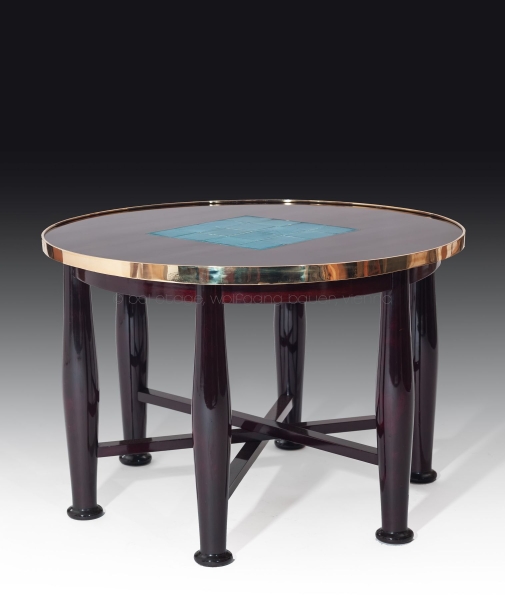In 1858, Carl Friedrich Heinrich Schmidt, who came from a family of carpenters in Saxony, decided to move to Vienna.
Like so many artists and craftsmen, Schmidt saw the imperial capital of Vienna, with its urban growth and the construction of the Ringstrasse, as a profitable opportunity for professional self-realization. After initially founding the wallpaper store "F. Schmidt & Sugg" at Bischofgasse 637 (now Rotenturmstraße In) in Vienna I together with Gerhard Joseph Hubert Sugg in 1859, Schmidt was able to take over the company in its entirety in 1872 and rename it "Friedrich Otto Schmidt".
The company experienced its commercial upswing when his eldest son Otto Erdmann Schmidt joined the company, which now offered complete furnishings including stucco decorations and fireplaces as a "technical studio for room decorations". The company not only advanced to become one of the most successful interior decorators in the second half of the 19th century, but also actively participated in Arthur von Scala's reform movement at the Museum of Art and Industry in Vienna, which set itself the declared goal of sustainably improving the interaction between art and craftsmanship in line with the English model and breaking with the tradition of historicism. Schmidt soon abandoned the historicizing imitation of older forms and concentrated on the exact copying of old models, from individual pieces of furniture to entire interiors.
When Carl Friedrich Heinrich Schmidt died in 1894 and his eldest son Otto in 1895, his other son Max Hermann took over the company. He joined the family business in 1889 and became the sole owner. Together with his two brothers Carl Leo and Hugo Wilhelm, he was able to change and expand the structure of the "Technical Studio for Home Furnishings" up to the turn of the century. In 1896, a second branch was established in Waisenhausgasse (now Boltzmanngasse) in Vienna IX in addition to the business premises at Rotenturmstraße 11 in Vienna I.
In 1897, a store was opened in Budapest.
In 1898, the company moved from Rotenturmstraße to the baroque Palais Neupauer-Breuner at Singerstraße 16 in Vienna I.
In 1900 and 1910, further branches were opened in Vienna V and Vienna IX, although these were closed again over the years. There was a particularly productive exchange with the architect Adolf Loos, who worked closely with Max Hermann Schmidt and inspired him, for example, to create the famous elephant trunk table (1899), which was used in different versions for various home furnishings from 1900 onwards. In addition to Loos, the company also worked with the Vienna Secession. The anteroom and the secretary's office in the Secession exhibition building were furnished according to plans by Josef Hoffmann.
Since 1907, Palais Chotek at Währinger Strasse 28 in Vienna IX has served as the company's headquarters. [...] The company "Friedrich Otto Schmidt" was one of the most exclusive and important interior designers of the Viennese Gründerzeit. Initially still in the style of historicism, which was based on the imitation of older styles, the company soon concentrated on the faithful reproduction of old models and thus created an unmistakable design language whose stylish furniture still stands for the highest quality today. Through its involvement in the reform ideas of the Museum of Art and Industry and the influence of Adolf Loos' modern design concepts, the company advanced to the avant-garde of Viennese arts and crafts around 1900. The company's success was confirmed by numerous participations in international exhibitions such as the World Exhibition in Vienna in 1873, the Millennium Exhibition in Budapest in 1896, the winter exhibitions in the k. k. Österreichisches Museum für Kunst und Industrie in Vienna 1898-1904 and the exhibition of works from the Austrian art industry 1850-1914, also at the k. k. Österreichisches Museum für Kunst und Industrie in Vienna in 1914.
Ref.: comp.: E. Ottillinger (ed.), Wagner, Hoffmann, Loos und das Möbeldesign der Wiener Moderne, Vienna, 2018, p. 147ff

 WRITING DESK
WRITING DESK  ROUND TABLE "HABERFELD"
ROUND TABLE "HABERFELD"  MECHANICAL GAMING TABLE À LA LOOS
MECHANICAL GAMING TABLE À LA LOOS  ARMCHAIR À LA LOOS
ARMCHAIR À LA LOOS  DISPLAY CABINET
DISPLAY CABINET  SIDE TABLE
SIDE TABLE  SMALL HANGING LAMP
SMALL HANGING LAMP  BIG DRAWING ROOM TABLE
BIG DRAWING ROOM TABLE  DRAWING ROOM TABLE À LA LOOS
DRAWING ROOM TABLE À LA LOOS  DRAWING ROOM TABLE
DRAWING ROOM TABLE  FOUR IMPORTANT ARMCHAIRS
FOUR IMPORTANT ARMCHAIRS  CHANDELIER
CHANDELIER  CHANDELIER
CHANDELIER  ELEPHANT TRUNK TABLE
ELEPHANT TRUNK TABLE  A PAIR OF ARMCHAIRS
A PAIR OF ARMCHAIRS  TABLE À LA LOOS
TABLE À LA LOOS  ROUND TABLE "HABERFELD"
ROUND TABLE "HABERFELD"  SIGNIFICANT ARMCHAIR
SIGNIFICANT ARMCHAIR  SIGNIFICANT ARMCHAIR
SIGNIFICANT ARMCHAIR  LARGE OVAL TABLE
LARGE OVAL TABLE  PRESTIGIOUS GLASS-FRONTED LIBRARY BOOKCASE
PRESTIGIOUS GLASS-FRONTED LIBRARY BOOKCASE  ROOM DIVIDER
ROOM DIVIDER  ELEPHANT TRUNK TABLE
ELEPHANT TRUNK TABLE  ELEPHANT TRUNK TABLE
ELEPHANT TRUNK TABLE